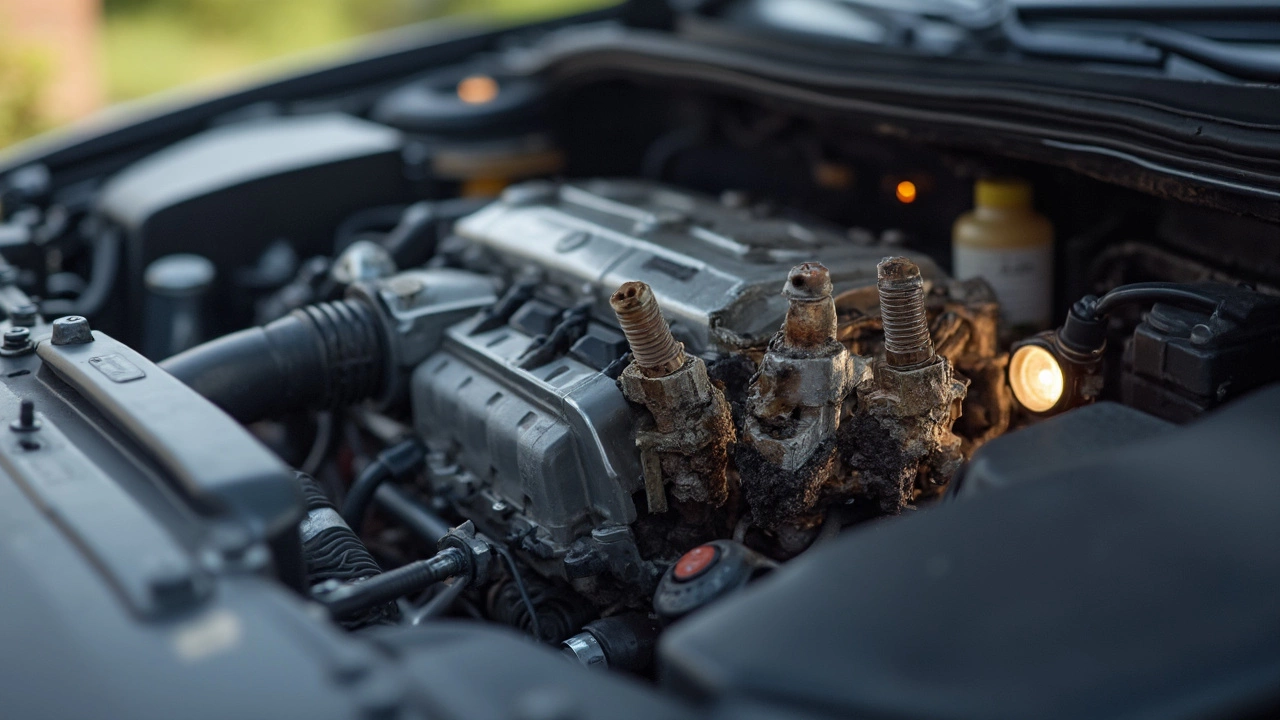So your car starts fine, idles smooth, and gets you from point A to B without trouble. Feels like you can ignore the spark plugs, right? It’s easy to think, "If it ain’t broke, don’t fix it." But here’s the twist—spark plugs can quietly wear down long before you notice any drama.
Today’s cars have smarter computers that compensate for weak spark plugs. That means your engine might adapt and run "okay" even as performance slowly drops. You won’t always get flashing warning lights or a shaky idle. But underneath the hood, those small plugs could be setting you up for bigger issues down the road, like bad fuel economy or a failed catalytic converter.
Let’s get real. Spark plugs are cheap compared to the repairs you could face if you push them to their bitter end. Regular changes don’t just check a box on your maintenance schedule—they keep your engine running its best and your wallet happier in the long haul.
- Why Spark Plugs Matter Even When Things Seem Fine
- Hidden Signs Your Spark Plugs Need Attention
- How Often Should You Really Change Spark Plugs?
- DIY Tips: Changing Spark Plugs the Smart Way
Why Spark Plugs Matter Even When Things Seem Fine
Here’s the thing about spark plugs: they’re the small parts doing the heavy lifting every time you drive. Each plug fires thousands of times a minute, lighting the air-fuel mix so your car can run. Sounds basic, but it has a huge impact on performance and even your fuel costs.
You might not see or hear any issues when they start to wear out, especially with modern engines that quietly hide minor problems. But the hidden truth is worn spark plugs make your engine work harder, burn more gas, and pollute more. According to Car and Driver, "A single faulty spark plug can drop fuel economy by up to 30%."
"People often don't realize spark plugs are a maintenance item, not just a repair. Keeping them fresh keeps your car running as it should." — John Nielsen, American Automobile Association (AAA) Director of Automotive Engineering and Repair
Think your car is fine? You might be giving up smooth starts, strong acceleration, and better mileage without knowing it. When engine performance seems okay but your car feels a little sluggish or your gas station visits become more frequent, aging spark plugs are often the culprit. You’ll also help protect bigger, more expensive parts like the catalytic converter by replacing plugs on schedule.
Check out how overlooked spark plugs can impact your ride:
| Issue | Potential Effect |
|---|---|
| Old spark plugs | Poor fuel economy |
| Worn electrodes | Slower acceleration |
| Intermittent firing | Engine misfires or rough idling |
| Missed changes | Damage to ignition coils & catalytic converter |
The bottom line? Even if your check engine light isn’t on, keep car maintenance in check. Swapping old plugs before things go south will save you time, fuel, and potentially some expensive repairs down the line.
Hidden Signs Your Spark Plugs Need Attention
Just because your car isn’t chugging or throwing warning lights doesn’t mean your spark plugs are in perfect shape. These little guys might be calling for help in ways that are easy to miss if you’re not looking for them.
The most common hidden sign is a slow drop in engine performance. Maybe you’ve noticed you’re filling the tank a bit more often—bad spark plugs make your engine work harder, and your fuel mileage quietly slips. Same goes for acceleration. If your ride used to have some punch and now it feels sluggish, worn plugs could be to blame.
Here are a few less-obvious symptoms:
- Tough starts: The engine cranks longer before firing up, especially on cold mornings.
- Brake pedal shakes at idle: That odd vibration in your foot when you stop could mean weak sparks, not just rough roads.
- Random hiss or pop: Occasional popping from the exhaust, especially when speeding up or slowing down suddenly.
- Check Engine light flashes and disappears: Sometimes a quick engine misfire triggers a momentary check engine light that goes away. Easily missed if you’re not watching for it.
Here’s a quick look at how worn spark plugs affect your car, based on some eye-opening service center data:
| Symptom | Effect on Driving | How Often Reported |
|---|---|---|
| Lower Gas Mileage | 3-7% decrease | Very common after 50,000 miles |
| Slow Start | Extra cranking: 1-2 seconds longer | Moderately common |
| Rough Idle | Noticeable shaking | Common, but often ignored |
If you spot any of these signs, it’s worth checking your spark plugs soon. Staying on top of it saves you headaches and keeps your engine happier for longer.

How Often Should You Really Change Spark Plugs?
The big question: how often do you actually need to change spark plugs? It totally depends on your car and the kind of plugs it uses. Older cars with copper plugs might need fresh spark plugs every 20,000 to 30,000 miles. On the other hand, newer rides using platinum or iridium plugs let you stretch that out to 60,000 miles—or even 100,000 miles in a lot of cases.
But here’s the kicker: don’t just go by what it “might” be. Always check your owner’s manual for the exact interval. Some manufacturers are really specific, and that’s for a good reason. Stretched intervals sound nice until you start losing fuel economy or your engine ends up harder to start on a cold morning.
| Type of Spark Plug | Typical Change Interval |
|---|---|
| Copper | 20,000 - 30,000 miles |
| Platinum | 60,000 miles |
| Iridium | up to 100,000 miles |
It’s easy to forget about car maintenance stuff like this since spark plugs work in the background. But knock a few minutes off your Netflix time every few years to keep track—trust me, your engine will thank you.
If you drive in harsh conditions, like stop-and-go traffic or dusty places, consider changing spark plugs a bit sooner. Extreme weather and frequent short trips put more stress on plugs than regular highway cruising. So, it’s not just about mileage—it’s about how and where you drive too.
DIY Tips: Changing Spark Plugs the Smart Way
Changing spark plugs yourself isn’t rocket science, and doing it right can save you cash and keep your engine humming. Here’s how to nail it on your own without making rookie mistakes.
First, make sure your engine is completely cool. Hot metal and hands don’t get along. You’ll need the right tools: a spark plug socket, ratchet, a gap gauge, and a torque wrench. Pick up spark plugs that match your ride exactly—check your owner’s manual for part numbers and specs.
- Locate spark plugs: Most cars have four, six, or eight, usually right on top of the engine block under coil packs or wires.
- Remove one at a time: Don’t yank out all the wires at once. Pull the wire or coil, then unscrew the plug. Doing them one by one keeps your wires in the right order.
- Check the gap: Use a gap gauge to measure the new plug. Don’t just trust what’s on the box. Incorrect gaps mean lousy engine performance and wasted gas.
- Tighten gently: Screw in the new plug by hand, then gently tighten with your torque wrench. Too tight and you could crack the plug—or worse, the engine head.
- Reconnect everything: Snap the wire or coil back on. Double check everything is snug and in the right spot.
One cool fact: research by NGK (one of the big spark plug makers) found that misfires from old spark plugs can slash your fuel economy by up to 30%. That’s money out the window every time you fill up. Here’s a quick table to break down how long common spark plug types last:
| Type of Spark Plug | Average Lifespan (miles) |
|---|---|
| Copper | 20,000 - 30,000 |
| Platinum | 60,000 - 100,000 |
| Iridium | 100,000+ |
Last tip: Always look at the old plugs before tossing them. Oily, black, or crusty plugs can tell you about other engine issues brewing under the surface. Snapping a pic before the swap can help if you need a mechanic’s advice later.
If you ever feel unsure, it’s totally fine to hit up a trusted mechanic. But if you’re comfortable and careful, DIYing your spark plugs is a smart, satisfying fix for engine performance and your budget.

